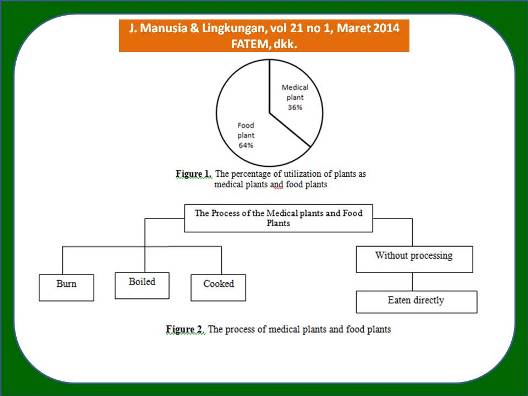
ETHNO-BIOLOGICAL NOTES ON THE MEYAH TRIBE FROM THE NORTHERN PART OF MANOKWARI, WEST PAPUA (Catatan Etnobiologi Pada Suku Meyah di Pantai Utara Manokwari, Papua Barat)
Sepus Fatem(1*), Mariana H. Peday(2), Rina N. Yowei(3)
(1) Fakultas Kehutanan, Universitas Negeri Papua Jl. Gunung Salju Amban, Manokwari Papua Barat 98314
(2) Fakultas Kehutanan, Universitas Negeri Papua Jl. Gunung Salju Amban, Manokwari Papua Barat 98314
(3) Fakultas Kehutanan, Universitas Negeri Papua Jl. Gunung Salju Amban, Manokwari Papua Barat 98314
(*) Corresponding Author
Abstract
ABSTRACT
Tropical forests provide many products such as fruits, seeds, resin, medicines, meat and by-products such as non-timber forest products. In June 2005, February 2008 and June 2009, ethno botanical and ethno zoological surveys were conducted among Meyah hunter-gatherers and on the flora and fauna. This paper aims to reveal the interaction between the Meyah Tribe in the Northern Part of Manokwari and utilization of forest products. Our study reports that the tribe used about 67 species of plants and 11 wild animals to support their livelihood. Due to the expansion of the Manokwari regency as part of the development process in West Papua Province, we would therefore like to suggest that the local government should pay attention to developing and preserving the biodiversity in this area.
ABSTRAK
Hutan tropis pada prinsipnya menyediakan berbagai kebutuhan manusia baik buah, biji, resin, tumbuhan obat, daging dan dikenal sebagai hasil hutan bukan kayu. Survei etnobiologi ini dilakukan pada bulan June 2005, Februari 2008 dan Juni 2009 pada masyarakat yang melakukan kegiatan pemanfaatan tumbuhan dan berburu satwa liar. Tulisan ini bermaksud untuk mengungkapkan interaksi Suku Meyah di Wilayah Pantai Utara Manokwari dalam pemanfaatan produk hasil hutan bukan kayu. Studi ini mencatat sekitar 67 spesies tumbuhan dan 11 jenis satwa lair yang di manfaatkan untuk menopang kehidupan suku Meyah. Data jumlah jenis tumbuhan dan satwa liar yang di manfaatkan ini, di harapkan dapat berguna bagi pemerintah daerah dan lembaga lainnya dalam mengatur pola pemanfaatan sumberdaya hutan non kayu. Dalam hubungan dengan pemekaran wilayah, maka tantangan terhadap kelestarian sumberdaya hutan ini sangat besar, karena diprediksi akan mengalami tekanan dan kerusakan. Dengan demikian siklus kehidupan masyarakat akan terganggu. Sehingga di butuhkan kebijakan guna mengakomodir kepentingan masyarakat asli dan juga kebutuhan pembangunan.
Keywords
Full Text:
Artikel lengkap (PDF) (Bahasa Indonesia)References
Alcorn, J.B., 1981. Huastec Non Crop Resources Management. Human Ecol., 9:395-417. Arnold M., dan Ruiz, P.M., 2001. Can Non Timber Forest Product Match Tropical Forest Conservation and Development Objectives. Ecol. Econo. 39:437-447. Bye, R.A., 1979. Incipient Domestication of Mustards in North West Mexico. Kiva 44:237-256. Badan Pusat Statistik Papua. 2004. Kantor Statistik Provinsi Papua Belcher, B., dan Kusters, K., 2004. Forest Product, Livelihoods and Conservation.Case Studies of Non Timber Forest Product Systems.Volume 1 ASIA. CIFOR Indonesia. Bodmer, R.E., Eisenberg, J.F., dan Redford, K.H., 1997. Hunting and Likelihood of Extinction of Amazonian mammals. Conser. Biol. 11:460-6. De Beer, J., dan McDermott, M., 1996. The economic Value of Non Timber Forest Product in Southeast Asia. IUCN Netherlands. Fatem, S., 2007. Types of Cuscus in the North Coast of Manokwari. Journal Biodiversitas, 8(2):233-237. Fatem, S., Warmetan, H., dan Bumbut, P.I., 2010. Peramelidae Mammals Species in the Northern Part of Manokwari, West Papua. J. Tiger Paper. 37:3 Koen, K., dan Belcher, B., 2004. Forest Products, Livelihoods and Conservation. Case Studies of Non Timber Forest Product Systems. Center for Internationak Forestry Research. Krimadi, E., 2009. Pemanfaatan Tumbuhan Obat Oleh Masyarakat di Kampus Inoduas, Pantai Utara Manokwari. KTI Fakultas Kehutanan Universitas Negeri Papua, Manokwari. Lee, R.J., 2000. Impact of Sub sistence Hunting in North Sulawesi, Indonesia and Conservation Options.In J.G. Robinson and E.L Bennett (eds). Hunting for Sustainability in Tropical Forest.New York; Columbia University Press. Miah, R.Md., 2003. Non Timber Forest Product and Co-Management; A Case Study of Chunati Wildlife Sanctuary.Journal of Institute of Forestry and Environmental Sciences. University of Chitagong, Bangladesh. Patai, M., 2005. Peluang Yang Memperlemah Masyarakat Adat. Yayasan Kemala. Jakarta. Powell, J.M., 1976. Etnobotani in K.Paijmans (eds), New Guinea Vegetation Elsiever Scientific Publishing Company. Amsterdam-Oxford-New York.
Article Metrics
Refbacks
- There are currently no refbacks.
Copyright (c) 2017 Jurnal Manusia dan Lingkungan







